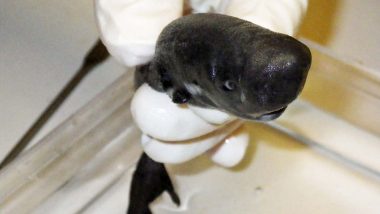A new species of shark that glows in the dark was found in the Gulf of Mexico by a team of researchers. Scientists say that the pocket shark shoots glow-in-the-dark fluid from pouches near its gills. The researchers from NOAA and Tulane University determined that the small kitefin shark which was initially found in 2010 is an American pocket shark, or Mollisquama mississippiensis, based on five features, as explained in a Tulane press release.
According to a study published in the Zootaxa journal, the glowing shark measures just 5.5 inches long. It has two pockets near its gills which secrete a luminous fluid that helps in attracting the prey. The only other known variety of pocket shark was discovered in the eastern Pacific Ocean in 1979, which is now in the Zoological Museum in St. Petersburg, Russia.

Mark Grace of NOAA'S NMFS Mississippi Laboratories in the press release says, "In the history of fisheries science, only two pocket sharks have ever been captured or reported. Both are separate species, each from separate oceans. Both are exceedingly rare." The glowing shark was found for the first time during a mission to study sperm whale feeding in 2010. Following which Grace came across the sperm whale while examining specimens during the NOAA survey in 2013.
Study author Henry Bart, from Tulane University Biodiversity Research Institute, to IFLScience, "If you can imagine how many fish have been trawled or fished from the sea, a number certainly in the billions, there has only been one of these captured and a single specimen of a related species." First author Mark Grace, of the NMFS Mississippi Laboratories of NOAA, to IFLScience, "Every time a new species is described it advances science, especially when novel scientific methods are used to describe the species, as was the case with the synchrotron imaging."
When the two species are compared, there are quite a few differences. The newly identified shark has fewer vertebrae and photophores, or light-producing glandular organs. While both sharks have pouches near their front fins, it was only after identifying the new species that scientists found out it emits a bioluminescent liquid to attract prey and hide.
(The above story first appeared on LatestLY on Jul 23, 2019 09:26 AM IST. For more news and updates on politics, world, sports, entertainment and lifestyle, log on to our website latestly.com).













 Quickly
Quickly




















